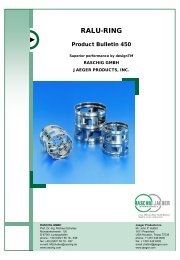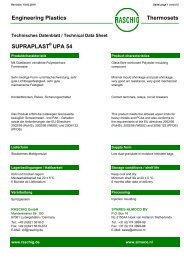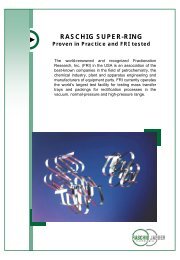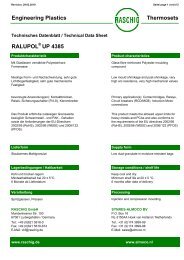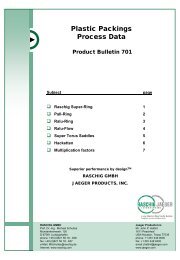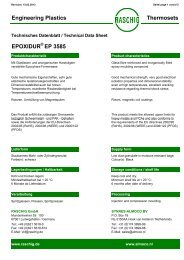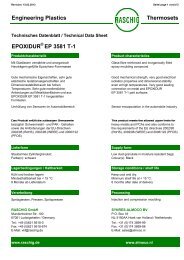Raschig Super-Ring
Raschig Super-Ring
Raschig Super-Ring
Create successful ePaper yourself
Turn your PDF publications into a flip-book with our unique Google optimized e-Paper software.
REACHING NEW PERFORMANCE LEVELS WITH SURFACE<br />
ENHANCED RASCHIG SUPER-PAK STRUCTURED PACKINGS<br />
By<br />
Simon Chambers,<br />
Michael Schultes,<br />
RASCHIG GmbH,<br />
Mundenheimerstrasse 100, 67071, Ludwigshafen, Germany.<br />
Keywords: <strong>Raschig</strong> <strong>Super</strong>-Pak, Surface Enhancement, Structured Packings,<br />
Useful Capacity, Hydraulics<br />
Presented in the Distillation Topical Conference of the 2007 Spring AIChE Meeting,<br />
Houston, Texas<br />
April 22 - 26, 2007<br />
© RASCHIG GmbH<br />
April 2007<br />
AIChE shall not be responsible for statements or opinions contained in papers<br />
or printed in its publications.<br />
1
Abstract<br />
In order to penetrate the popular 250 m 2 /m 3 structured packing market, a technically superior and<br />
commercially viable alternative to <strong>Raschig</strong> <strong>Super</strong>-Pak-300 (RSP-300) was developed: the <strong>Raschig</strong><br />
<strong>Super</strong>-Pak-250 (RSP-250 wSE). It has a surface area of 250 m 2 /m 3 . The rows of sinusoidal waves<br />
within vertical packing sheets are surface enhanced to encourage greater turbulent radial spread of thin<br />
liquid film flows on the front and back of the waves on each sheet within an element. RSP-250 wSE<br />
was tested at SRP, University of Texas at Austin under identical total reflux conditions to RSP-300 [1]<br />
on the cyclohexane/n-heptane system at four operating pressures to characterise performance.<br />
The effect of surface enhancement on the mass transfer efficiency of RSP-250 wSE compared to<br />
<strong>Raschig</strong> <strong>Super</strong>-Pak 300 without surface enhancement (RSP-300 woSE) is significant with consistently<br />
lower HETP values. On comparing with the Montz B1-250 and B1-250M [2] as well as F.R.I. tested<br />
Sulzer Mellapak M250Y and MellapakPlus M252Y at 0.34 and 1.65 bar (5 and 24 psia) system<br />
pressures [3], the hydraulic-efficiency results for RSP-250 wSE are outstanding.<br />
For all system pressures, the pressure drop of RSP-250 wSE are significantly lower by an order of<br />
magnitude than the 250 m 2 /m 3 surface area standard structured packings and significantly less than the<br />
high capacity types at high flow rates. Combined with excellent efficiencies, the pressure drop per<br />
theoretical stage is even more impressive.<br />
Given the outstanding hydraulic and mass transfer efficiency performance, the credentials of RSP-250<br />
wSE competing in the 250 m 2 /m 3 surface area structured packing market can now be firmly<br />
established.<br />
1. Introduction<br />
At the 2006 AIChE Spring National Meeting, <strong>Raschig</strong> <strong>Super</strong>-Pak structured packing was introduced<br />
[1] that is fundamentally different to the standard and high capacity corrugated sheet metal structured<br />
packings. The familiar corrugated sheet metal packing types typically have a crimp angle of 45 o (60 o<br />
for lower pressure drop) and vendors use various techniques in an attempt to optimise wetting by using<br />
surface enhancements and/or holes on the metal sheets. A common feature, however, is that both<br />
standard and high capacity structured packings have discreet crimped channels that force vapourliquid<br />
traffic along preferred flow paths. Additionally the vapour-liquid traffic is forced into sharp<br />
directional changes at the packing layer interface when packing elements are vertically stacked at<br />
alternating 90 o orientations. The net result is that the enforced vapour-liquid flow patterns within the<br />
‘closed’ structure of a packing element do not necessarily utilize all of the available surface area for<br />
mass transfer and impose restrictive forces that affect capacity and pressure drop.<br />
<strong>Raschig</strong> GmbH adopted a different approach in developing <strong>Raschig</strong> <strong>Super</strong>-Pak. It is a more open<br />
structure such that vapour-liquid traffic can flow freely within a packing element and at the layer<br />
interface where sharp directional changes are minimised. The first packing investigated was <strong>Raschig</strong><br />
<strong>Super</strong>-Pak 300 without surface enhancement and from here on labelled RSP-300woSE. The open<br />
structure resulted in excellent hydraulic and mass transfer efficiency characteristics as verified in total<br />
reflux distillation tests at the Separations Research Program (SRP), University of Texas at Austin [1].<br />
2. Background<br />
The impressive performance of RSP-300woSE raised questions whether hydraulic-efficiency<br />
comparisons with a packing of surface area 300 m 2 /m 3 can be made with 250 m 2 /m 3 surface area was<br />
fair. Faced with this challenge, and in order to penetrate the popular 250 m 2 /m 3 structured packing<br />
market, a technically superior and commercially viable alternative to <strong>Raschig</strong> <strong>Super</strong>-Pak-300 was<br />
developed: the <strong>Raschig</strong> <strong>Super</strong>-Pak-250 (RSP-250 wSE). It has a surface area of 250 m 2 /m 3 and<br />
2
consists of a regular sequence of sinusoidal waves above and below the plain of the metal sheet at a<br />
45 o angle of orientation. Packing sheets are arranged vertically side-by-side with opposing<br />
inclinations of rows of waves to form a layer as shown in Figure 1. Packing sheets are surface<br />
enhanced to encourage greater turbulent radial spread of thin liquid film flows on the front and back of<br />
the waves via numerous contact points on each sheet within an element. It maximises available<br />
surface area for mass transfer: a feature that is questionable with ‘closed’ channels in corrugated sheet<br />
types. Combined with lower shear stress forces encountered by countercurrent vapour flow, the net<br />
result is very high capacities, low pressure drops and excellent mass transfer performance.<br />
Hydraulic performance of the new surface enhanced <strong>Raschig</strong> <strong>Super</strong>-Pak-250, RSP-250 wSE was<br />
studied at the University of Texas at Austin Separations Research Program (SRP). Pressure drop<br />
measurements with increasing gas capacity factor at select constant liquid rates using Air-Water are<br />
shown in Figure 2. RSP-250 wSE shows equivalent performance with RSP-300woSE at low vapour<br />
rates but lower pressure drops and greater capacity of up to 18% as vapour rate is increased.<br />
3. Test Unit and Experimental Procedures<br />
To further characterize the surface enhanced RSP-250 wSE, SRP conducted total reflux distillation<br />
tests using the cyclohexane/n-heptane (C 6 /C 7 ) test system at operating pressures of 0.165, 0.33, 1.65<br />
and 4.14 bar. Performance of the RSP-250 wSE structured packing is compared against the Montz<br />
B1-250 and B1-250M conventional and high capacity structured packings tested under identical<br />
conditions as reported by Olujic et al [2]. As with the RSP-300 test, the RSP-250wSE hydraulic and<br />
mass transfer data at 1.65 bar pressure are compared against B1-250 and B1-250M packing<br />
measurements at 1.03 bar since no runs were made at 1.65 bar. In addition results are compared<br />
against F.R.I. tested Sulzer Mellapak M250.Y and MellapakPlus M252.Y structured packings on the<br />
C 6 /C 7 at 0.34 and 1.65 bar test systems as reported by Pilling and Spiegel [3].<br />
Distillation tests were performed in the SRP 0.43 m ID column with a bed height of 3.05 m. The<br />
liquid distributor used was the SRP high capacity narrow trough drip tube distributor, with 145 pour<br />
points/m 2 and liquid flow rate range of 5 to 50 m 3 /m 2 /h. A complete description of the experimental<br />
set up, operating procedures and computation of results can be found elsewhere [1,5].<br />
Hydraulic results, in the form of pressure drop per unit height (ΔP/H), pressure drop per theoretical<br />
stage (ΔP/Stage), and mass transfer results (HETP) are all plotted against vapour rate (F S -Factor)<br />
based on bottom of the column conditions.<br />
4. Results and Discussion<br />
4.1 Liquid Rate and Operating Pressure Effect on Efficiency<br />
At all four pressures the effect of surface enhancement on the mass transfer efficiency of RSP-250<br />
wSE compared to <strong>Raschig</strong> <strong>Super</strong>-Pak 300 without surface enhancement RSP-300woSE [1] is<br />
significant with consistently lower HETP values up to 50 mm. Representative examples at 0.33 and<br />
1.65 bar are shown in Figure 3. With each operating pressure, the HETP is fairly constant up to the<br />
loading regime followed by a sustained dip in HETP values, indicative of improved mass transfer<br />
efficiency, prior to a sharp break in the HETP curve as the packing enters incipient flood. The<br />
exception was at 4.14 bar because the reboiler capacity had reached its upper limit prior to flooding.<br />
Regardless of pressure, HETP values are generally between 0.283 and 0.358 m.<br />
Because RSP-250wSE, RSP-300woSE, B1-250M and M252.Y are high capacity devices it is worth<br />
noting how close the capacities are to System Limit as opposed to hydraulic flood. In reality 250<br />
m 2 /m 3 surface area high capacity structured packings fall short of this condition in their mode of<br />
operation.<br />
3
For each operating pressure, 90% of System Limit is superimposed in Figure 3 and subsequent figures<br />
below. As higher the operating pressure, the further away the abrupt rise in HETP for RSP-250wSE is<br />
with respect to the 90% System Limit such that hydraulic film flood occurs. Figure 3 shows an<br />
example at 1.65 bar operating pressure. With decreasing pressure, the rise in the RSP-250wSE HETP<br />
curve at the highest flow rates actually reach a critical point where it crosses the 90% limit. It is<br />
illustrated in Figure 3 with 0.33 bar operating pressure. Overall, it implies that as lower the operating<br />
pressure, the higher the tendency of high performance structured packings such as <strong>Raschig</strong> <strong>Super</strong>-Pak<br />
250wSE to approach and even exceed 90% System Limit before it enters full hydraulic film flood.<br />
4.2 Efficiency<br />
Capacity-efficiency comparative plots of RSP-250wSE with the standard B1-250 [2] and F.R.I. tested<br />
M250.Y [3, 4] as well as the high capacity B1-250M [2] and F.R.I. tested M252Y [3] are presented in<br />
Figures 4 and 5 on the C 6 /C 7 1.65 bar test system. The RSP-250wSE HETP values are consistently<br />
lower than both the standard and high capacity 250m 2 /m 3 surface area packings over the entire<br />
operating range. In Figure 4 the HETP in the mid capacity range at 1.65 bar pressure for RSP-<br />
250wSE is 0.334 m compared to 0.355 m and 0.385 m for B1-250 and M250.Y respectively. On<br />
comparing with the high capacity structured packings, the 0.334 m HETP value for RSP-250wSE in<br />
the mid capacity range is lower than 0.375 m for RSP-300woSE [1], 0.379 m for the B1-250M and<br />
0.355 m for M252Y as shown in Figure 5.<br />
At 0.33 bar operating pressure, the RSP-250wSE HETP values are consistently lower than both the<br />
standard and high capacity 250m 2 /m 3 surface area packings as shown in Figures 6 and 7. Compared to<br />
the standard types, HETP in the mid capacity range for RSP-250wSE in Figure 6 is 0.342 m compared<br />
to 0.356 m with B1-250 [2] and 0.483 m for M250.Y [3,4]. On comparing with high capacity<br />
structured packings in Figure 7, the 0.342 m HETP for RSP-250wSE in the mid capacity range is<br />
lower than 0.387 m for RSP-300woSE [1], 0.413 m for B1-250M [2] and 0.374 m for M252Y [3].<br />
4.3 Useful Capacity<br />
For both test pressures, RSP-250wSE shows a clear maximum useful capacity advantage (defined<br />
above) compared to both the standard and high capacity structured packings. This is summarised in<br />
the Maximum Useful Capacity – Flow Parameter charts in Figures 8 and 9. Flow Parameter is<br />
(ρ V /ρ L ) 0.5 since L/V = 1. Each Figure shows the maximum useful capacity gain of RSP-250wSE over<br />
the standard and high capacity 250m 2 /m 3 surface area packings [2,3,4] at 0.165, 0.33 and 1.65 bar<br />
operating pressures. Also shown is the 90 % System Limit for each pressure. Comparisons were not<br />
made at 4.14 bar because the reboiler capacity had reached its upper limit prior to flooding. Standard<br />
B1-250 is used as a reference point for useful capacity comparisons.<br />
In Figure 8 the maximum useful capacity for RSP-250wSE is 2.84 Pa 0.5 compared to 2.32 and 2.24<br />
Pa 0.5 for B1-250 and M250.Y at 1.65 bar. It represents a capacity advantage of 23 and 26 %<br />
respectively. Similarly at 0.33 bar, a value of 3.42 Pa 0.5 for RSP-250wSE is 27 % greater than for B1-<br />
250 at 2.67 Pa 0.5 and 34 % higher than M250.Y at 2.56 Pa 0.5 . At the lowest pressure of 0.165 bar the<br />
RSP-250wSE maximum useful capacity is 3.72 Pa 0.5 compared to 2.88 Pa 0.5 for B1-250, which<br />
represents an advantage of 29%.<br />
Figure 9 shows the maximum useful capacity comparisons of RSP-250wSE against the high capacity<br />
structured packings. At 1.65 bar the maximum useful capacity for RSP-250wSE is 2.84 Pa 0.5 compared<br />
to 2.83, 2.61 and 2.65 Pa 0.5 for RSP-300 woSE [1], B1-250M [2] and M252.Y [3]. Useful capacities<br />
of RSP-250wSE and RSP-300woSE are almost identical, while there is a 7 to 9% increase over the<br />
B1-250M and M252.Y. At 0.33 bar, the RSP-250wSE maximum useful capacity of 3.42 Pa 0.5 is 1 %<br />
higher than RSP-300woSE at 3.40 Pa 0.5 , 8 % greater than B1-250M at 3.17 Pa 0.5 and 6 % higher than<br />
M252.Y at 3.245 Pa 0.5 . Maximum useful capacities of RSP-250wSE and RSP-300wSE are close to the<br />
90% System Limit.<br />
4
For the lowest operating pressure of 0.165 bar, a useful capacity of 3.73 Pa 0.5 for RSP-250wSE<br />
exceeds the 90% System limit by 2% and is 4% greater than both RSP-300woSE and B1-250M with<br />
each having a maximum useful capacity of 3.59 Pa 0.5 .<br />
The useful capacity advantage of RSP-250wSE over the high capacity B1-250M and M252.Y<br />
structured packings is remarkable given that the flow channels in adjacent RSP-250wSE packing<br />
layers are at 90 o with respect to one another when vertically stacked. Unlike the ‘closed’ channels of<br />
corrugated structured packings, the open structure of <strong>Raschig</strong> <strong>Super</strong>-Pak alleviates any restrictions in<br />
vapour-liquid flows at the element interface where layers touch.<br />
4.4 Hydraulic-Pressure Drop Comparison<br />
Pressure drop comparative plots of RSP-250wSE with both standard B1-250 [2], M250.Y [3, 4] and<br />
high capacity RSP-300woSE [1], B1-250M [2] and M252.Y [3] packings are presented in Figures 10<br />
and 11 for 1.65 and 0.33 bar test pressures. No pressure drop data were reported at 1.65 bar for the<br />
F.R.I. M250.Y test in 1987. For both pressures RSP-250wSE pressure drops were less than the<br />
standard B1-250 and M250.Y by an order of magnitude and an average 37 % below that of the high<br />
capacity B1-250M and M252.Y at high flow rates. The pressure drop of RSP-250wSE tracks that of<br />
RSP-300woSE but is lower at the highest flow rates, particularly at 0.33 bar (see Figure 11).<br />
The convergence of maximum useful capacity of RSP-250wSE, RSP-300woSE and M252Y at 0.33<br />
bar operating pressure, suggests that the on-set of hydraulic film flooding is very close to or crossing<br />
the 90% System Limit. The pressure drop curve of Sulzers’ high capacity structured packing M252Y<br />
runs much more in line with both RSP-250wSE and RSP-300woSE than the Montz high capacity B1-<br />
250M. This may be an effect of the test facility as M252Y was tested at F.R.I. while B1-250M as well<br />
as both <strong>Raschig</strong> <strong>Super</strong>-Pak structured packings had been tested at SRP.<br />
4.5 Pressure Drop per Theoretical Stage Comparison<br />
Pressure drop per theoretical stage is an important parameter in evaluating different structured packing<br />
designs. Figures 12 and 13 show pressure drop per theoretical stage comparisons of RSP-250wSE<br />
both with standard B1-250 [2], M250.Y [3, 4] and high capacity RSP-300woSE [1], B1-250M [2] and<br />
M252.Y [3] packings. At 1.65 bar operating pressure, the pressure drops per theoretical stage of RSP-<br />
250wSE is consistently lower than both the standard and high capacity 250m 2 /m 3 surface area<br />
packings. The pressure drops per theoretical stage of RSP-250wSE trends that of RSP-300woSE over<br />
the entire operating range. With 0.33 bar operating pressure, results are even more impressive such<br />
that the pressure drops per theoretical stage of RSP-250wSE is not only lower than the standard<br />
250m 2 /m 3 surface area packings but the high capacity B1-50M, M252.Y and RSP-300woSE as well.<br />
On the whole the excellent hydraulic advantages of RSP-250wSE over the B1-250M and M252.Y<br />
high capacity structured packings is a remarkable result. Although adjacent <strong>Raschig</strong> <strong>Super</strong>-Pak 250<br />
layers are rotated 90 o with respect to one another when vertically stacked, the influence is insignificant<br />
because of the fully open structure that permits vapour-liquid traffic to flow more freely within a<br />
packing element and at the layer interface. This is in contrast to the B1-250M and M252.Y high<br />
capacity types with curvature of the corrugations gradually changing from 45 o to 0 o on vertical axis at<br />
one or both ends of the packing elements.<br />
5
5. Conclusions<br />
The effect of surface enhancement on the mass transfer efficiency of RSP-250 wSE compared to<br />
<strong>Raschig</strong> <strong>Super</strong>-Pak 300 without surface enhancement (RSP-300 woSE) is significant with consistently<br />
lower HETP values by at least 50 mm on all four test pressures. On comparing with the Montz B1-<br />
250 and B1-250M [2] as well as F.R.I. tested Sulzer Mellapak M250Y and MellapakPlus M252Y at<br />
0.34 and 1.65 bar (5 and 24 psia) system pressures [3, 4], the hydraulic-efficiency RSP-250 wSE<br />
results are outstanding. The RSP-250 wSE maximum useful capacities are 29 and 23 % higher than<br />
B1-250 on 0.33 and 1.65 bar system pressures. For the same conditions, RSP-250 wSE measured<br />
efficiencies are around 20% better than B1-250. Comparisons against M250Y, indicate the capacityefficiency<br />
advantages are even greater. When checked against the high capacity B1-250M and<br />
M252Y, the RSP-250 wSE maximum useful capacities are up to 6 to 8 % higher with up to 36 %<br />
lower HETP values (better efficiency).<br />
For all system pressures, the pressure drop of RSP-250 wSE are consistently lower by an order of<br />
magnitude than the 250 m 2 /m 3 surface area standard structured packings and at least 35 % lower than<br />
the high capacity types at high flow rates. It also matches the pressure drop of RSP-300 woSE but the<br />
RSP-250 wSE pressure drop is lower at the highest rates in the loading regime. Combined with<br />
excellent efficiencies, the pressure drop per theoretical stage is even more impressive.<br />
Given the outstanding hydraulic and mass transfer efficiency performance, the credentials of RSP-250<br />
wSE competing in the 250 m 2 /m 3 surface area structured packing market are now firmly established.<br />
Acknowledgements<br />
The authors would like to acknowledge the efforts of Professor Jim Fair, Dr. Frank Seibert, Mr.<br />
Christopher Lewis and Mr. Steve Briggs for their excellent work on the <strong>Raschig</strong> <strong>Super</strong>-Pak 250 with<br />
surface enhancement testing program.<br />
6. References<br />
[1] Schultes, M., Chambers, S., “How To Surpass Conventional and High Capacity Structured<br />
Packings with <strong>Raschig</strong> <strong>Super</strong>-Pak”, AIChE Spring National Meeting, Orlando, FL,<br />
23-27 April, 2006.<br />
[2] Olujic, Z., Seibert, A.F., Kaibel, B., Jansen, H., Rietfort, T., Zich. E., “Performance of a New<br />
High Capacity Structured Packing”, AIChE Spring National Meeting, Houston, TX,<br />
22-26 April, 2001.<br />
[3] Pilling, M., Spiegel, L., “Design Characteristics and Test Validation of High Performance<br />
Structured Packing”, Distillation Symposium, Distillation Honors John Kunesh, AIChE<br />
November National Meeting, Reno Nevada, November 4-9, 2001.<br />
[4] Fitz, C. W., Kunesh, J. G., and Shariat, A., "Performance Of Structured Packing in a<br />
Commercial-Scale Column At Pressures of 0.02-27.6 Bar", I.& E.C. Research, 38, 1999, p. 512.<br />
[5] Olujic, Z., Seibert, A. F., Kaibel, B., Jansen, H., Rietfort, T., Zich. E., “Effect of Perforations on<br />
the Performance of High Capacity Structured Packings with Large Surface Area”, AIChE<br />
Spring National Meeting, New Orleans, 30 March - 2 April, 2003.<br />
[6] Stupin, W. J., and Kister, H. Z., "System Limit: The Ultimate Capacity of Fractionators", Trans.<br />
IChemE., Vol. 81, Part A, January 2003, page 136.<br />
6
Nomenclature<br />
C 6<br />
C 7<br />
Cyclohexane<br />
n-Heptane<br />
F S √Pa or m/s(kg/m 3 ) 1/2 Gas or vapour capacity factor = u S ⋅ ρV<br />
H m Packing height<br />
HETP m height equivalent to a theoretical stage<br />
L kg/h Liquid mass flow rate<br />
p bar operating / system pressure<br />
u L m 3 /m 2 h superficial liquid velocity<br />
u S m/s superficial vapour velocity<br />
V kg/h Gas or vapour mass flow rate<br />
Greek letters<br />
ΔP Pa, mbar Pressure drop<br />
ρ L kg/m 3 Liquid density<br />
ρ V kg/m 3 Gas or vapour density<br />
Index<br />
s<br />
<strong>Super</strong>ficial<br />
Rows of Loops at<br />
45 o angle<br />
Packing sheets<br />
arranged vertically<br />
Figure 1. Photographs of Segment of <strong>Raschig</strong> GmbH <strong>Raschig</strong> <strong>Super</strong>-Pak 250<br />
with Surface Enhancement, RSP-250 wSE<br />
7
Pressure Drop, Pa/m packing<br />
2500<br />
2000<br />
1500<br />
1000<br />
500<br />
Hydraulic Performance of <strong>Raschig</strong> RSP-250wSE vs RSP-300woSE<br />
RSP-250 DP<br />
Dry<br />
RSP-300 DP<br />
Dry<br />
RSP-250<br />
24.48 m3/m2h<br />
RSP-300<br />
24.48 m3/m2h<br />
RSP-250<br />
36.72 m3/m2h<br />
RSP-300<br />
36.72 m3/m2h<br />
RSP-250<br />
48.96 m3/m2h<br />
RSP-300<br />
48.96 m3/m2h<br />
RSP-250<br />
73.44 m3/m2h<br />
RSP-300<br />
73.44 m3/m2h<br />
0<br />
0.00 1.00 2.00 3.00 4.00 5.00<br />
F-factor (m/s) (kg/m 3 ) 0.5<br />
Figure 2. Pressure drop per meter packed height comparison of <strong>Raschig</strong> <strong>Super</strong>-Pak RSP-250wSE vs.<br />
RSP-300woSE for select constant liquid rates. Column ID 0.43 m, Bed Height 3.05 m. Air/water<br />
tests at Separations Research Program, University of Texas at Austin, Austin, Texas.<br />
HETP, m<br />
Liquid Rate, gpm/ft 2<br />
0.0 4.0 8.0 12.0 16.0 20.0 24.0<br />
0.80<br />
90 % System Limit<br />
0.70<br />
0.60<br />
0.50<br />
0.40<br />
0.30<br />
0.20<br />
30.94<br />
27.94<br />
24.94<br />
21.94<br />
18.94<br />
15.94<br />
12.94<br />
9.94<br />
6.94<br />
HETP, inches<br />
0.10<br />
3.94<br />
0.0 10.0 20.0 30.0 40.0 50.0 60.0<br />
Liquid Rate, m 3 /m 2 /h<br />
RSP-250 wSE - 0.333 bar [4.83 psia]<br />
RSP-300 woSE - 0.333 bar [4.83 psia]<br />
RSP-250 wSE - 1.655 bar [24.0 psia]<br />
RSP-300 woSE - 1.655 bar [24.0 psia]<br />
Figure 3. Effect of liquid rate and operating pressure on HETP of <strong>Raschig</strong> <strong>Super</strong>-Pak RSP-250wSE<br />
compared with RSP-300woSE at total reflux, 0.43 m I.D. SRP Column, 3.05 m Bed, C6/C7 System,<br />
High capacity drip tube distributor<br />
8
HETP, m<br />
0.00 0.40 0.80 1.20 1.60 2.00 2.40 2.80 3.20<br />
0.80<br />
0.70<br />
0.60<br />
0.50<br />
0.40<br />
0.30<br />
0.20<br />
p = 1.03 - 1.65 bar<br />
Mellapak Tested in<br />
1.22m F.R.I. Column<br />
Fs-Factor, ft/s(lb/ft 3 ) 0.5<br />
90 % System Limit<br />
0.10<br />
3.94<br />
0.00 0.50 1.00 1.50 2.00 2.50 3.00 3.50 4.00<br />
Fs-Factor, Pa 0.5<br />
30.94<br />
27.94<br />
24.94<br />
21.94<br />
18.94<br />
15.94<br />
12.94<br />
RSP-250 wSE B1-250 [1.03 bar] M250.Y 1987 TDP (midbed 44-53%, 61-79%C6)<br />
Figure 4 Mass transfer efficiency (HETP) comparison at total reflux. <strong>Raschig</strong> <strong>Super</strong>-Pak<br />
RSP-250 wSE vs. Standard B1-250 [1.03 bar] and M250Y (FRI 1987) at 1.655 bar,<br />
0.43 m I.D. SRP column, 3.05 m bed, C 6 /C 7 system, High capacity distributors.<br />
9.94<br />
6.94<br />
HETP, inches<br />
HETP, m<br />
0.80<br />
0.70<br />
0.60<br />
0.50<br />
0.40<br />
0.30<br />
0.20<br />
0.00 0.40 0.80 1.20 1.60 2.00 2.40 2.80 3.20<br />
p = 1.03 - 1.65 bar<br />
Mellapak Tested in<br />
1.22m F.R.I. Column<br />
Fs-Factor, ft/s(lb/ft 3 ) 0.5<br />
90 % System Limit<br />
0.10<br />
3.94<br />
0.00 0.50 1.00 1.50 2.00 2.50 3.00 3.50 4.00<br />
Fs-Factor, Pa 0.5<br />
30.94<br />
27.94<br />
24.94<br />
21.94<br />
18.94<br />
15.94<br />
12.94<br />
9.94<br />
6.94<br />
HETP, inches<br />
RSP-250 wSE<br />
M252.Y VKG 6.7 mm (midbed 34-58%C6)<br />
RSP-300 woSE<br />
B1-250M [1.03 bar]<br />
Figure 5 Mass transfer efficiency (HETP) comparison at total reflux. <strong>Raschig</strong> <strong>Super</strong>-Pak<br />
RSP-250 wSE vs. RSP-300 woSE, High Capacity B1-250M [1.03 bar] and M252Y (FRI) at 1.655 bar,<br />
0.43 m I.D. SRP column, 3.05 m bed, C 6 /C 7 system, High capacity distributors<br />
9
Fs-Factor, ft/s(lb/ft 3 ) 0.5<br />
0.00 0.40 0.80 1.20 1.60 2.00 2.40 2.80 3.20<br />
0.80<br />
0.70<br />
p = 0.33 bar<br />
90 % System Limit<br />
30.94<br />
27.94<br />
HETP, m<br />
0.60<br />
0.50<br />
0.40<br />
0.30<br />
0.20<br />
Mellapak Tested in<br />
1.22m F.R.I. Column<br />
24.94<br />
21.94<br />
18.94<br />
15.94<br />
12.94<br />
9.94<br />
6.94<br />
HETP, inches<br />
0.10<br />
0.00 0.50 1.00 1.50 2.00 2.50 3.00 3.50 4.00<br />
Fs-Factor, Pa 0.5<br />
RSP-250 wSE M250.Y 1987 TDP (midbed 40-96%, 90-96%C6) B1-250<br />
Figure 6 Mass transfer efficiency (HETP) comparison at total reflux. <strong>Raschig</strong> <strong>Super</strong>-Pak<br />
RSP-250 wSE vs. Standard B1-250 and M250Y (FRI 1987) at 0.333 bar,<br />
0.43 m I.D. SRP column, 3.05 m bed, C 6 /C 7 system, High capacity distributors<br />
3.94<br />
Fs-Factor, ft/s(lb/ft 3 ) 0.5<br />
0.00 0.40 0.80 1.20 1.60 2.00 2.40 2.80 3.20<br />
0.80<br />
p = 0.33 bar<br />
90 % System Limit<br />
0.70<br />
30.94<br />
27.94<br />
HETP, m<br />
0.60<br />
0.50<br />
0.40<br />
0.30<br />
0.20<br />
Mellapak Tested in<br />
1.22m F.R.I. Column<br />
0.10<br />
3.94<br />
0.00 0.50 1.00 1.50 2.00 2.50 3.00 3.50 4.00<br />
Fs-Factor, Pa 0.5<br />
24.94<br />
21.94<br />
18.94<br />
15.94<br />
12.94<br />
9.94<br />
6.94<br />
HETP, inches<br />
RSP-250 wSE RSP-300 woSE M252.Y VKG 5.3 mm (midbed 45-52%C6) B1-250M<br />
Figure 7. Mass transfer efficiency (HETP) comparison at total reflux. <strong>Raschig</strong> <strong>Super</strong>-Pak<br />
RSP-250 wSE vs. RSP-300 woSE, High Capacity B1-250M and M252Y (FRI) at 0.333 bar,<br />
0.43 m I.D. SRP column, 3.05 m bed, C 6 /C 7 system, High capacity distributors.<br />
10
3.80<br />
90% System Limit<br />
3.00<br />
Max. Useful Cap. F vmax - Pa 0.5<br />
3.40<br />
3.00<br />
29%<br />
34%<br />
27%<br />
2.20<br />
2.60<br />
23%<br />
C6/C7<br />
26%<br />
0.165 bar<br />
C6/C7<br />
2.00<br />
0.333 bar<br />
2.20<br />
1.80<br />
0.0100 C6/C7 0.1000<br />
Flow Parameter = (RhoV / RhoL) 0.5<br />
1.65 bar<br />
2.80<br />
2.60<br />
2.40<br />
Max. Useful Cap. F vmax - ft/s(lb/ft 3 ) 0.5<br />
RSP-250wSE M250Y FRI 1987 B1-250<br />
Figure 8. Maximum Useful Capacity based HETP at Different Pressures versus Flow Parameter<br />
Comparison. <strong>Raschig</strong> <strong>Super</strong>-Pak RSP-250 wSE vs. RSP-300 woSE,<br />
And Standard B1-250 and M250Y (FRI 1987)<br />
4.00<br />
3.25<br />
Max. Useful Cap. F vmax - Pa 0.5<br />
3.50<br />
3.00<br />
4% 4%<br />
C6/C7<br />
0.165 bar<br />
6%<br />
8%<br />
C6/C7<br />
0.333 bar<br />
90% System Limit<br />
7% 9%<br />
2.85<br />
2.45<br />
Max. Useful Cap. F vmax - ft/s(lb/ft 3 ) 0.5<br />
2.50<br />
2.05<br />
0.0100 0.1000<br />
Flow Parameter = (RhoV / RhoL) 0.5<br />
C6/C7<br />
1.65 bar<br />
RSP-250wSE RSP-300 woSE M252Y B1-250M<br />
Figure 9. Maximum Useful Capacity based HETP at Different Pressures versus Flow Parameter<br />
Comparison. <strong>Raschig</strong> <strong>Super</strong>-Pak RSP-250 wSE vs. RSP-300 woSE,<br />
And High Capacity B1-250M and M252Y (FRI)<br />
11
DP/H, mbar/m<br />
Fs-Factor, ft/s(lb/ft 3 ) 0.5<br />
0.00 0.40 0.80 1.20 1.60 2.00 2.40 2.80 3.20<br />
18.0<br />
15.0<br />
12.0<br />
9.0<br />
6.0<br />
p = 1.03 - 1.65 bar<br />
90 % System Limit<br />
2.00<br />
1.60<br />
1.20<br />
0.80<br />
DP/H, in.H 2 0/ft<br />
3.0<br />
Mellapak Tested in<br />
1.22m F.R.I. Column<br />
0.40<br />
0.0<br />
0.00<br />
0.00 0.50 1.00 1.50 2.00 2.50 3.00 3.50 4.00<br />
Fs-Factor, Pa 0.5<br />
RSP-250 wSE<br />
M252.Y VKG 6.7 mm (midbed 34-58%C6)<br />
B1-250 [1.03 bar]<br />
RSP-300 woSE<br />
B1-250M [1.03 bar]<br />
Figure 10. Pressure drop (ΔP/H) comparison at total reflux. <strong>Raschig</strong> <strong>Super</strong>-Pak<br />
RSP-250 wSE vs. RSP-300 woSE, B1-250, B1-250M and M252Y (FRI),<br />
1.655 bar, 0.43 m I.D. SRP column, 3.05 m bed, C 6 /C 7 system, High capacity distributors<br />
Fs-Factor, ft/s(lb/ft 3 ) 0.5<br />
0.00 0.40 0.80 1.20 1.60 2.00 2.40 2.80 3.20<br />
18.0<br />
p = 0.33 bar<br />
15.0<br />
90 % System Limit<br />
2.00<br />
DP/H, mbar/m<br />
12.0<br />
9.0<br />
6.0<br />
3.0<br />
Mellapak Tested in<br />
1.22m F.R.I. Column<br />
1.60<br />
1.20<br />
0.80<br />
0.40<br />
DP/H, in.H 2 0/ft<br />
0.0<br />
0.00<br />
0.00 0.50 1.00 1.50 2.00 2.50 3.00 3.50 4.00<br />
Fs-Factor, Pa 0.5<br />
RSP-250 wSE<br />
RSP-300 woSE<br />
M252.Y VKG 5.3 mm (midbed 45-52%C6)<br />
B1-250M<br />
M250.Y 1987 TDP (midbed 40-96, 90-96%C6) B1-250<br />
Figure 11. Pressure drop (ΔP/H) comparison at total reflux. <strong>Raschig</strong> <strong>Super</strong>-Pak<br />
RSP-250 wSE vs. RSP-300 woSE, B1-250, M250Y (FRI 1987), B1-250M and M252Y (FRI),<br />
0.333 bar, 0.43 m I.D. SRP column, 3.05 m bed, C 6 /C 7 system, High capacity distributors<br />
12
DP/Stage, mbar<br />
Fs-Factor, ft/s(lb/ft 3 ) 0.5<br />
0.00 0.40 0.80 1.20 1.60 2.00 2.40 2.80 3.20<br />
12.0<br />
9.0<br />
6.0<br />
3.0<br />
p = 1.03 - 1.65 bar<br />
Mellapak Tested in<br />
1.22m F.R.I. Column<br />
90 % System Limit<br />
4.50<br />
4.00<br />
3.50<br />
3.00<br />
2.50<br />
2.00<br />
1.50<br />
1.00<br />
0.50<br />
DP/Stage, in.H 2 0<br />
0.0<br />
0.00<br />
0.00 0.50 1.00 1.50 2.00 2.50 3.00 3.50 4.00<br />
Fs-Factor, Pa 0.5<br />
RSP-250 wSE<br />
M252.Y VKG 6.7 mm (midbed 34-58%C6)<br />
B1-250 [1.03 bar]<br />
RSP-300 woSE<br />
B1-250M [1.03 bar]<br />
Figure 12. Pressure Drop per Theoretical Stage comparison at total reflux. <strong>Raschig</strong> <strong>Super</strong>-Pak<br />
RSP-250 wSE vs. RSP-300 woSE, B1-250, B1-250M and M252Y (FRI),<br />
1.655 bar, 0.43 m I.D. SRP column, 3.05 m bed, C 6 /C 7 system, High capacity distributors<br />
DP/Stage, mbar<br />
Fs-Factor, ft/s(lb/ft 3 ) 0.5<br />
0.00 0.40 0.80 1.20 1.60 2.00 2.40 2.80 3.20<br />
12.0<br />
9.0<br />
6.0<br />
3.0<br />
p = 0.33 bar<br />
90 % System Limit<br />
4.50<br />
4.00<br />
3.50<br />
3.00<br />
2.50<br />
2.00<br />
1.50<br />
1.00<br />
DP/Stage, in.H 2 0<br />
0.0<br />
0.00<br />
0.00 0.50 1.00 1.50 2.00 2.50 3.00 3.50 4.00<br />
Fs-Factor, Pa 0.5<br />
RSP-250 wSE<br />
RSP-300 woSE<br />
M252.Y VKG 5.3 mm (midbed 45-52%C6)<br />
B1-250M<br />
B1-250 M250.Y 1987 TDP (midbed 40-96, 90-96%C6)<br />
Figure 13. Pressure Drop per Theoretical Stage comparison at total reflux. <strong>Raschig</strong> <strong>Super</strong>-Pak<br />
RSP-250 wSE vs. RSP-300 woSE, B1-250, M250Y (FRI 1987), B1-250M and M252Y (FRI),<br />
0.333 bar, 0.43 m I.D. SRP column, 3.05 m bed, C 6 /C 7 system, High capacity distributors<br />
0.50<br />
13



